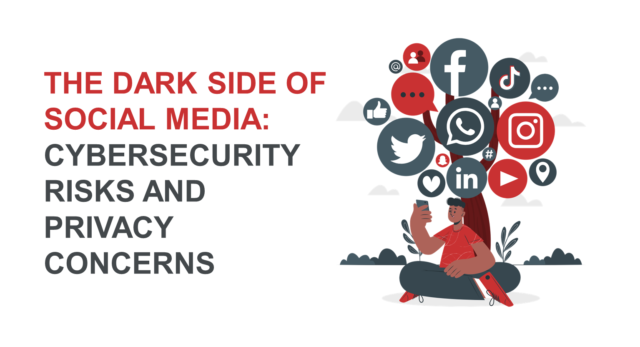Unveiling the Shadows: Social Media’s Dark Side of Privacy and Security Concerns
Introduction
In the advanced age, social media has turned into a vital piece of our regular routines, associating individuals across the globe and giving stages to self-expression, communication, and systems administration. While these stages offer various advantages, the negative aspect of social media secrecy and security concerns has arisen as a developing and inauspicious issue. In this article, we will dig into the different components of this dark side, investigating the dangers to client protection and the security challenges that have heightened in the tremendous scene of social media.
Privacy Erosion: Unraveling the Threads
Data Harvesting and Profiling
Social media stages are many times depicted as free spaces where clients can share their considerations, photographs, and individual data. Notwithstanding, underneath this apparently harmless façade lies an intricate snare of information collecting and client profiling. Social media monsters utilize modern algorithms that persistently gather and break down client information, making nitty gritty profiles that embody individual inclinations, ways of behaving, and even psychological traits.
This wide set of information empowers designated advertising as well as raises worries about the abuse of individual personal data. Cases of third party applications getting access to user information without approval and offering it to the most noteworthy bidder have lighted debates about the moral limits of information harvesting on social media.
Invasive Surveillance and Stalking
The actual idea of social media urges clients to impart their lives to other people, however this accessibility includes some major disadvantages. The simplicity with which information is shared on these stages makes individuals vulnerable against prominent examination and following. Stalkers can take advantage of geotagging highlights, photograph metadata, and registration presents on target a user’s area and schedules.
Instances of cyberstalking and bugging have risen, filled by the openness of individual data on social media. Clients, reliably ignorant about the dangers, end up familiar with as shown by those with risky clarification. The negative side of social media protection isn’t simply speculative; it’s a genuine and clear gamble that different people face in their web-based correspondences.
Security Breaches: Cracks in the Digital Armor
Hacking and Account Takeovers
As social media platforms have developed, so have the strategies utilized by programmers to break client security. Account takeovers, where hackers gain unapproved admittance to client accounts, have become progressively normal. Powerless passwords, lacking authentication processes, and phishing assaults are among the numerous weaknesses taken advantage by hackers to take-down accounts.
The repercussions of hacked accounts stretch out past the immediate burden of losing access to one’s profile. Programmers can control individual data, spread falsehood, or take part in fraud, making enduring harm the victims status and mental prosperity.
Cyber Attacks on Social Media Platforms
The dark side of social media security concerns stretches out past individual records to the actual software’s . Social media accounts, with millions or even billions of followers, are ideal objectives for cyber attacks. From data spilling to refined hacking, these attacks can think twice about security of gigantic proportions of client information.
The aftermath from such break-ins incorporates the unapproved access and burglary of individual information, which might be sold on the dark web or utilized for vindictive purposes. The ramifications of these security slips are not restricted to the virtual domain; they can have true results, influencing people and associations.
Ethical Dilemmas: Balancing Innovation and User Protection
The Fine Line of Consent
One of the principal moral catch in the space of social media turns around the chance of client assent. While client tensely offer data on these platforms, how much their information is collected, investigate, and shared is consistently hazy. The adaptable catch of user agreements routinely troubled with lawful language, can make it hard for clients to comprehend the repercussions of their assent completely.
Finding some kind of harmony between permitting advancement in information driven technologies and defending client security requires straightforward strategies and informed assent systems. The moral obligation lies with clients to comprehend the terms as well as with social media software’s to impart their practices obviously and dependably.
Accountability and Regulation
The outstanding development of social media has dominated administrative structures, leaving a void in responsibility. The deficiency of strong rules has allowed social media software to work in a modestly unhampered climate, provoking the misleading of client data without palatable assent.
The prerequisite for thorough and enforceable rules that consider social media answerable for protection breaks and security slips is more squeezing than any time in ongoing memory. Legislatures, shareholders, should team up to lay out a structure that safeguards client interests while promoting development.
Mitigating the Risks: Navigating the Shadows
User Empowerment through Education
Notwithstanding mounting protection and security concerns, it is foremost to engage clients through instruction. Mindfulness campaigns and effectively available assets can assist users with understanding the potential dangers related with social media use. Teaching users about protection settings, secure secret key practices, and perceiving phishing attempts can altogether upgrade their advanced proficiency and versatility against possible dangers.
Strengthening Platform Security Measures
Social media programming’s ought to track down proactive ways of supporting their wellbeing measures. This incorporates executing powerful validation processes, consistently refreshing security conventions, and putting resources into cutting edge innovations to distinguish and foil digital dangers. Platforms ought to zero in on client security over solace, discovering some sort of congruity that ensures a predictable client experience without compromising the prosperity of client data.
Advocating for Ethical Practices and Regulation
Clients, advocacy groups, and industry pioneers should all in all support for moral and ethical practices and powerful administrative structures. Compelling social media platforms to take on straightforward information rehearses, focus on client security, is vital for making a more secure online world.
Conclusion
Social media, with its gigantic reach and effect, has changed how we partner and grant. In any case, the obfuscated side of social media security and security concerns makes a concealed region over this digital scene. From the crumbling of safety through data gathering to the oncoming risks of cyberattacks, the threats are intricate.
Tending to these worries requires a purposeful exertion from users, social media stages, and administrative bodies. By encouraging digital proficiency, executing tough safety efforts, and upholding for moral practices, we can explore the shadows and make a safer and capable social media environment. An opportunity to divulge the dark side of social media and make a conclusive move is presently, as the outcomes of inaction could have broad ramifications for people and society in general.








